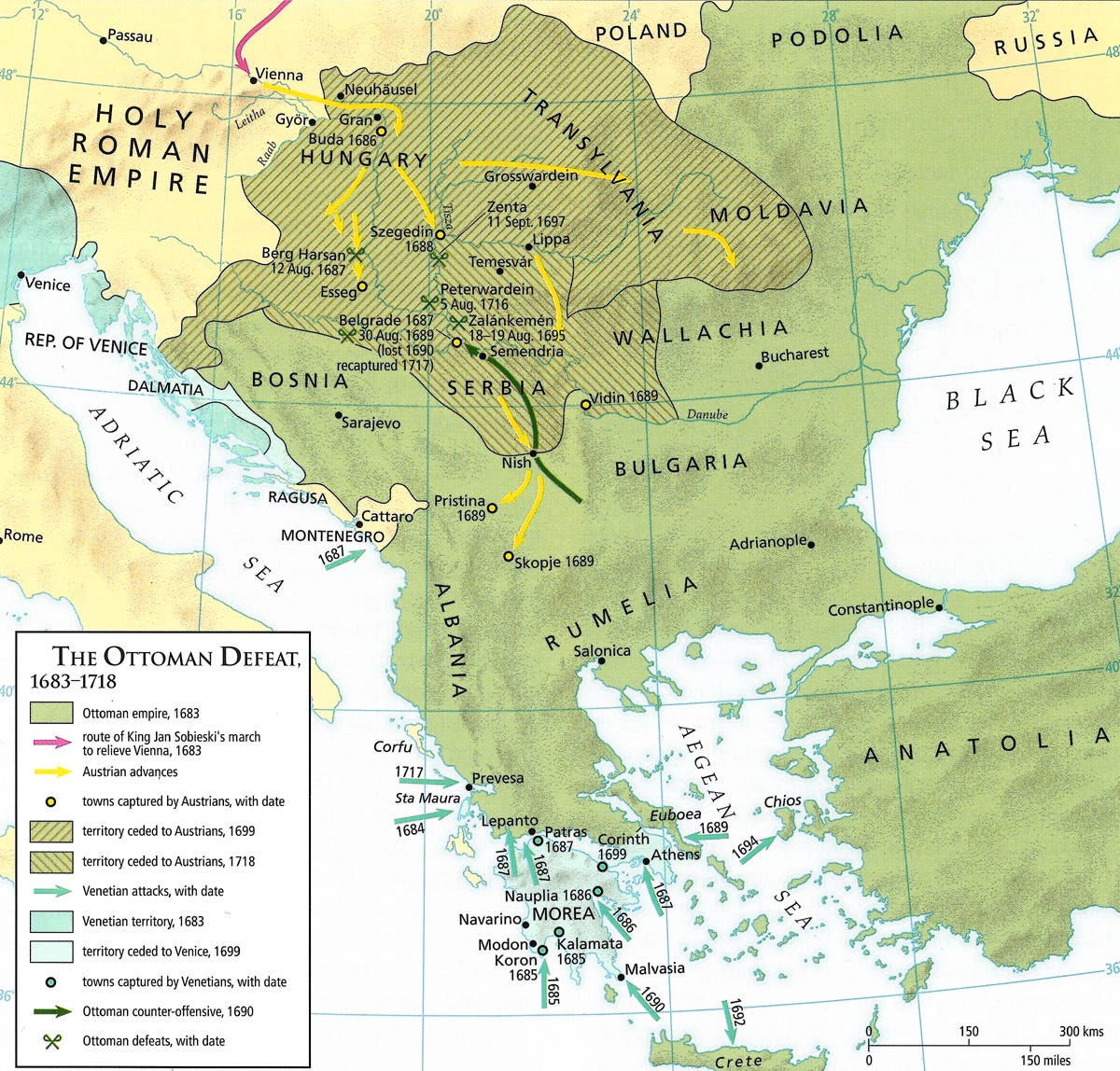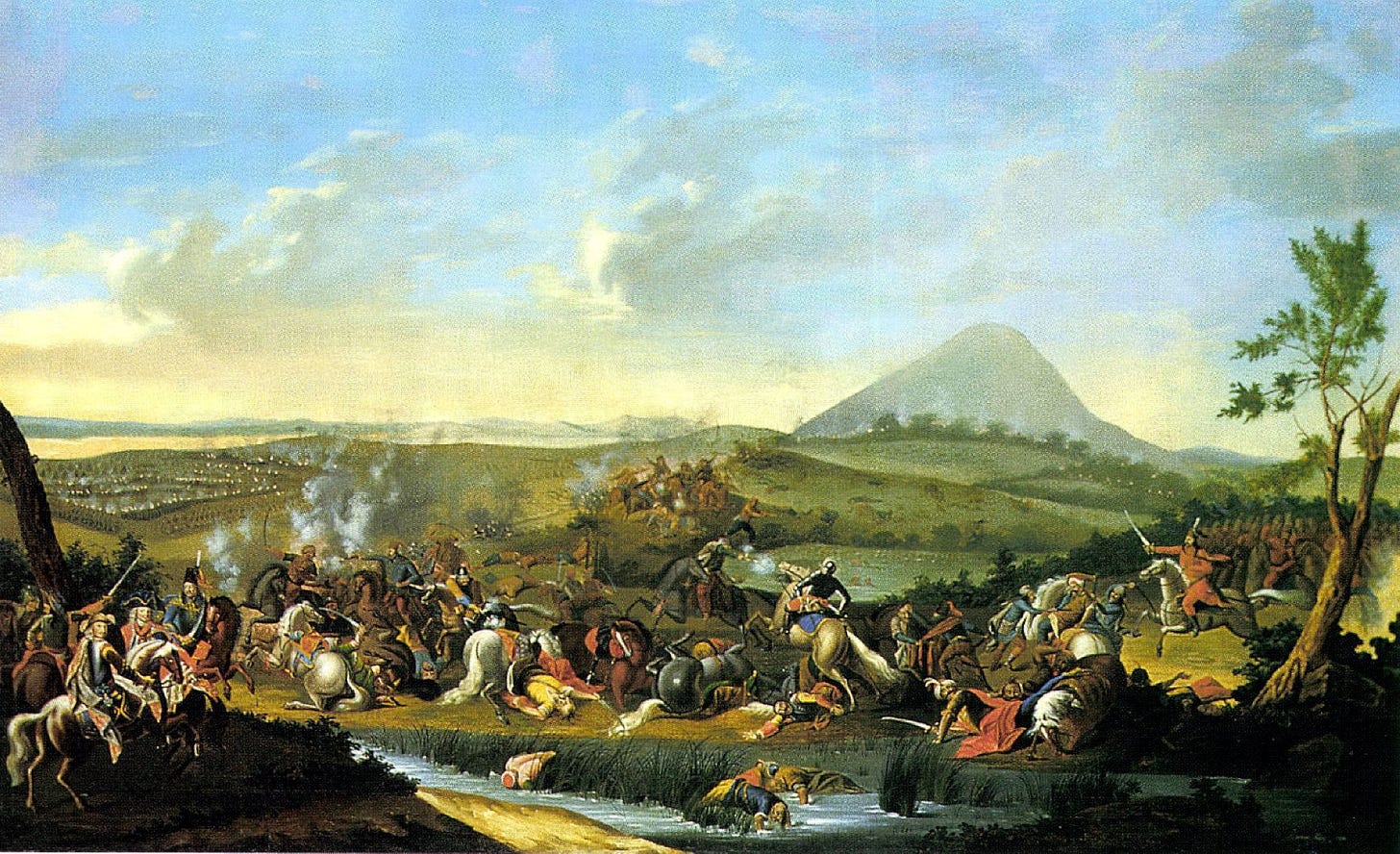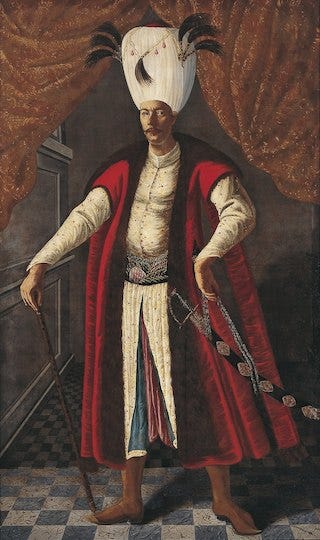Today in European history: the Battle of Mohács (1687)
The Habsburgs chase the retreating Ottoman Empire out of Hungary for good.
If you’re interested in history and foreign affairs, Foreign Exchanges is the newsletter for you! Sign up for free today for regular updates on international news and US foreign policy, delivered straight to your email inbox, or subscribe and unlock the full FX experience:
Today is the anniversary of the second of two major Ottoman battles at Mohács, in southern Hungary. The anniversary of the first, which took place in 1526, will come around in a couple of weeks. Although they shared a setting and one combatant, the two battles of Mohács couldn’t have gone more differently. In the first, an expanding Ottoman Empire won a decisive victory that allowed it to conquer much of Hungary. In the second, today’s subject, a retreating Ottoman Empire was chased out of Hungary for good.
This second Battle of Mohács was part of the 1683-1699 Great Turkish War, which pitted the Ottomans against one of the several “Holy Leagues” thrown together over the decades to try to counter them. This version included the Habsburg Empire, Russia, Poland-Lithuania, Venice, Hungary, Croatia, and some scattered Greek and Cossack forces. The war started with a failed Ottoman siege of Vienna, and after that the Ottomans spent most of the rest of the war losing territory to the various European powers. Ultimately the war would end with the 1699 Treaty of Karlowitz, which was really the first time the Ottomans were forced to conclude a peace treaty on European terms and which thus marks a real turning point in the long history of the Ottoman Empire. It also established the Habsburgs and Russia as the two rising powers in Eastern Europe.

Mohács was primarily fought between the Habsburgs (with a substantial number of allied Bavarian troops) and the Ottomans. The Habsburgs were led by Duke Charles V of Lorraine (Habsburg Emperor Leopold I’s brother in law) and the Ottomans by their Grand Vizier, Sarı Süleyman Pasha. Both armies are thought to have numbered around 60,000 men. The Europeans were on the offensive, trying to follow up their 1683 victory at Vienna, and despite Ottoman interference they were able to cross the Drava River in eastern Croatia in late July, at which point they began moving north toward the town of Siklós (also in southern Hungary). The Ottomans decided to strike while the Habsburgs were on the move, which they believed would allow them to concentrate their numbers and take advantage of a localized numerical advantage by overwhelming Charles’s left wing. Unfortunately for the Ottomans, they hadn’t reckoned on their own commander’s incompetence.
Ottoman artillery began shelling the Habsburg forces, but after an initial cavalry charge failed, Sarı Süleyman Pasha ordered the Ottoman army to adopt its familiar tactic of setting up fortifications and playing defense. This gave the Habsburg right wing time to get on the field, at which point Charles ordered a counter-attack. Sarı Süleyman Pasha then countermanded his earlier order and prepared to attack again, which basically left the Ottoman army in a state of confusion. The Habsburgs again held off the Ottoman advance and then attacked themselves, and because Sarı Süleyman Pasha hadn’t been able to make up his mind earlier in the battle, the Ottoman defenses were only half-finished. The Habsburgs were able to rout the Ottoman infantry, and the terrain prevented a last-ditch Ottoman cavalry counter-attack. In all, the Habsburg/Bavarian army lost about 600 men to the Ottomans’ roughly 10,000.
Now, the Ottoman Janissaries could be prickly under any circumstances, but after a costly and humiliating defeat like this they were pissed, and they knew exactly who to blame: Sarı Süleyman Pasha. The Grand Vizier enjoyed the ignominy of having to run away from his own army, which he managed to do successfully…until he made the mistake of running back home to Istanbul. The army naturally followed him there, and then decided to throw itself a good old fashioned mutiny.
The Sultan at the time, Mehmed IV (d. 1693), had ruled for almost 40 years, since 1648. He was the second-longest reigning Ottoman sultan in the empire’s history, behind only Süleyman the Magnificent, and while things are about to end badly for him the fact is that for much of his time on the throne the empire did quite well for itself. Which is not to say that Mehmed was a terribly effective emperor, since for almost the entirety of his reign the real responsibility for running the empire rested with his Grand Viziers.
It wasn’t necessarily a bad idea for sultans to take a back seat like this, especially if (as seems to have been the case with Mehmed, who apparently enjoyed hunting quite a bit) the actual work of governing wasn’t something that especially interested them. A hands-off emperor did need a Grand Vizier who knew what he was doing, and for most of Mehmed’s time in power he was blessed with very strong viziers from the famed Köprülü family. Köprülü Mehmed Pasha assumed the vizierate in 1656, and was followed by his son and then his son in-law. Collectively they held the office until 1683. They handled the empire ably, not only restoring stability after a period of internal chaos but actually resuming its expansion for a time. Under their watch the empire recovered the Aegean islands, including Crete, and extend its domain well into modern Ukraine.
However, the idea of vesting power in the Grand Vizier turned out not to be such a great idea when the Grand Vizier was, shall we say, a buffoon. Mehmed had ordered the execution of his last Köprülü vizier, Kara Mustafa Pasha, after the failed siege of Vienna. He came to regret it after Mohács. His soldiers now demanded the execution of Sarı Süleyman Pasha, which they got on September 18, but then they decided that they’d also had enough of Mehmed, who was deposed on November 8 in favor of his younger brother, Süleyman II (d. 1691). The new emperor eventually returned the Köprülüs to the vizierate, which they held until 1711 during the reign of Ahmed III.
The victory at Mohács and the subsequent chaos within the Ottoman Empire allowed the Habsburg army to conquer a large chunk of Eastern Europe, including parts of modern Croatia (the region of Slavonia), Serbia, Slovakia, Hungary, and Romania (Transylvania, to be precise). Their capture of Hungary at basically the same spot where the Ottomans had taken it for themselves in 1526 is one of history’s most compelling bookends, in my opinion.



